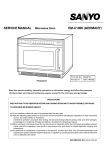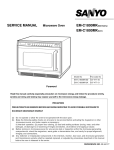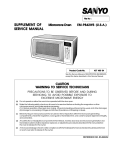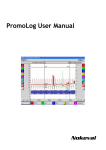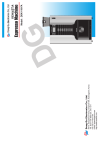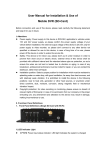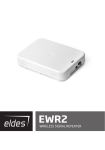Download SERVICE MANUAL Microwave Oven EM
Transcript
SERVICE MANUAL Microwave Oven EM-C1900M(UK) Pro.Code No. Model No. 437 624 00 EM-C1900MUK Foreword Read this manual carefully, especially precaution on microwave energy, and follow the procedure strictly, careless servicing and testing may expose yourself to the microwave energy leakage. PRECAUTIONS PRECAUTIONS TO BE OBSERVED BEFORE AND DURING SERVICING TO AVOID POSSIBLE EXPOSURE TO EXCESSIVE MICROWAVE ENERGY (a) Do not operate or allow the oven to be operated with the door open. (b) Make the following safety checks on all ovens to be serviced before activating the magnetron or other microwave source, and make repairs as necessary: (1)Interlock operation, (2) proper door closing, (3) seal and sealing surfaces (arcing, wear, and other damage), (4) damage to or loosening of hinges and latches, (5) evidence of dropping or abuse. (c) Before turning on microwave power for any service test or inspection within the microwave generating compartments, check the magnetron, wave guide or transmission line, and cavity for proper alignment, integrity, and connections. (d) Any defective or misadjusted components in the interlock, monitor, door seal, and microwave generation and transmission systems shall be repaired replaced, or adjusted by procedures described in this manual before the oven is released to the owner. REFERENCE NO. SM-6310023-00 - TABLE OF CONTENTS Adjustment Procedures ............................................. 1 Specifications ............................................................ 2 Power output Measurement ....................................... 2 Precautions and Repair Service Tips ......................... 2 Circuit Diagram .......................................................... 3 Test Procedures and Troubleshooting......................4-10 Disassembly Instructions .................................... 11-14 Exploded View and Parts List ............................. 15-22 Control Circuit Board.................................................23 Overall Circuit Diagram........................................24-25 CAUTION MICROWAVE RADIATION PERSONNEL SHOULD NOT BE EXPLOSED TO THE MICROWAVE ENERGY WHICH MAY RADIATE FROM THE MAGNETRON OR OTHER MICROWAVE GENERATING DEVICE IF IT IS IMPROPERLY USE OR CONNECTED. ALL INPUT MICROWAVE CONNECTIONS, WAVEGUIDE, FLANGES, AND GASKETS MUST BE SECURE. NEVER OPERATE THE DEVICE WITHOUT A MICROWAVE ENERGY ABSORBING LOAD ATTACHED. NEVER LOOK INTO AN OPEN WAVEGUIDE OR ANTENNA WHILE THE DEVICE IS ENERGIZED. (6) Make sure the microwave energy leakage should be no greater than 5 mW/cm2 to allow to measurement uncertainty when measured with a detector. (All service adjustments must be made for minimum microwave energy leakage readings.) NOTE: If the interlock monitor circuit operates and at the same time the fuse blows with the door opened, be sure to replace the control circuit board because relay 3 and 4 on the control circuit board, the door sensing switch and the electric circuit related on the door sensing switch, which act as Secondary Interlock switch. 1. ADJUSTMENT PROCEDURES Lever stopper TO AVOID POSSIBLE EXPOSURE TO MICROWAVE ENERGY LEAKAGE, THE FOLLOWING ADJUSTMENTS OF THE INTERLOCK SWITCHES SHOULD BE MADE ONLY BY AUTHORIZED SERVICE PERSONNEL. Interlock monitor switch Latch Lever PRIMARY INTERLOCK SWITCH, INTERLOCK MONITOR SWITCH AND DOOR SENSING SWITCH ADJUSTMENT (Figure 1) (1) Loosen 2 screws securing the lever stopper. (2) Adjust the lever stopper position so that it is pushed up and pull backward until there is about zero gap between the latch lever and the switch body on the door primary interlock switch and the at the same time there is about zero gap between latch lever and the switch body on the door sensing switch when the door latch is securely locked. (3) Tighten the lever stopper screws securely. (4) Make sure the interlock monitor switch closes after the primary interlock switch opens the door is opened very slowly, according to “CHECKOUT PROCEDURE FOR SWITCHES” on page 6. (5) Make sure the interlock monitor switch opens beforethe primary interlock switch closes when the door is closed very slowly, according to CHECKOUT PROCEDURE FOR SWITCHES” on page 7. Primary Interlock switch Latch Lever Door sensing switch Screws - 1 - Figure 1 2.SPECIFICATIONS Microwave output ................. 1,900W to 190W Frequency............................ 2,450MHz Power supply ....................... 230V, 50Hz Rated current ....................... 12.8Amp. Safety Device ...................... Thermal limitter (Magnetron) 150 °C Open Thermistor (Magnetron) ... 165 °C Open Thermistor(Duct) ............. 120 °C Open Fuse (Cartridge Type) ...... 250V 10Ax2 Micro switch, Relay Primary interlock Switch Interlock monitor Switch Door sensing Switch and Relay RL-3 and 4 Max. input time .................... Electronic Digital, up to Manual 10min.(max) 30min.(low power) Overall Dimensions ......... 422(W)x540(D)x335(H) mm Oven cavity size ............. 330(W)x330(D)x230(H) mm Effective Capacity of Oven Cavity ................. 19.1 liters Net weight ........................... 32Kg 3. POWER OUTPUT MEASUREMENT (1) Prepare 1000+5g tap water. (2) Adjust water temperature to 10 ± 2 °C . (3) Pour water into a container made of borosilicate Glass, 190mm outer diameter cylinder, maximum 3mm thickness. Note :Use the container kept on the room temperature. (4) place the container on the center of oven cavity. (5) Set the heating time for 26 seconds and rating full power and then start oven. (6) Take the container out immediately when heating time is up. (7) Stir water for making even water temperature in the container. (8) Measure water temperature. Water temperature rise shall be 8 to 12 °C. 4. PRECATIONS AND REPAIR SERVICE TIPS PRELIMINARY A. SINCE NEALY 4,000 VOLTS EXISTS IN SOME CIRCUITS OF THIS MICROWAVE OVEN, REPAIRS SHOULD BE CARRIED OUT WITH GREAT CARE. B. TO AVOID POSSIBLE EXPOSURE TO MICROWAVE ENERGY LEAKAGE, THE FOLLOWING PRECATIONS MUST BE TAKEN BEFORE SERVICING. - 2 - (1) Before the power is applied. (a) Open and close door several times to make sure sure the door interlock switch and interlock monitor monitor switch operation properly. (Listen for the clicking sound from switches.) make sure the interlock monitor switch is closed after the latch interlock switch is open when the door is opened. (See pages 1 and 8) (b) Make sure the perforated screen and the choke dielectric of the door are correctly mounted. (2) After the power is applied. (a) Open and close the door to see if the interlock mechanism operates properly. (b) Check microwave energy leakage with a leakage detector and confirm the energy leakage is below 5mW/c ㎡ . (3) Do not operate the unit until it is completely repaired if any of the following conditions exists. (a) Door is not closed firmly against the cavity front. (b) The hinge is broken. (c) The choke dielectric or the door seal is damaged. (d) The door is bent or warped, or there is any other visible damage to the oven that may cause microwave energy leakage. Note: Always keep the seal clean. (e) Make sure that there are no defective parts in the interlock mechanism. (f) Make sure that there are no defective parts in the microwave generating and transmission assembly. (especially wave guide) (4) Following items should be checked after the unit is repaired. (a) The interlock monitor switch is connected correctly and firmly. (b) The magnetron gasket on the magnetron is properly positioned. (c) Waveguide and oven cavity are intact. (No leakage of microwave energy). (d) The door can be properly closed and the safety switches work properly. (e) The oven must be stopped when the door is opened or the time is up. The oven must not be operated with any of the above components removed or bypassed. HINT FOR LAMP-CHANGE Before removing the cabinet, pull out the main-plug. If you want to check the new lamp with the open Cabinet, take care of the following safety-cautions: Do not touch live parts. The lamp holder is not connected to the earth protection lead by a metric screws. 5.CIRCUIT DIAGRAM EM-C1900M *Caution :The voltage between filament leads of magnetron is about 3.3VA.C, but the filament carries 4KV D.C high voltage with respect to grand. Never touch these lead with bare hand during operation. - 3 - COMPONENT HIGH-VOLTAGE CAPACITOR Including bleeder resistor HIGH-VOLTAGE DIODE CHECKOUT PROCEDURE RESULT Measure the resistance: Across two terminals with an ohm-meter on highest scale. Normal reading: Momentarily indicates several ohms, and gradually to 10 meg-ohms. Abnormal reading: Indicates continuity or 10 meg-ohms from the beginning. Measure the resistance: Across two terminals with an ohm-meter on highest scale. Normal reading: Indicate about the middle position in one direct (forward) and infinite ohms in the reverse direction, using meter with a 9volt battery. NOTE - Some digital meter may show over even in a forward direction because low measuring voltage of meter does not allow the meter to pass through the high voltage diode. Abnormal reading: Indicates continuity or infinite ohms in both directions. FUSE DIODE Measure the resistance: Across two terminals with an ohm-meter on highest scale. Normal reading: Indicate infinite ohms in both directions. Abnormal reading: Indicates continuity in both directions or continuity in one direction and infinite ohms in reversed direction. - 5 - - 7 - B. TROUBLESHOOTING CONDITION TROUBLE Connection of S110 to S107 Power is applied with normal voltage Timer is set Touch Select key CHECK No display cooking time Cooking operation will not start Fuse(10A) blows off immediately REMEDY Poor Contact Reconnect Power circuit board (See page 6) Voltage incorrect Replace Control circuit board (See page 6) Voltage incorrect Replace No continuity Replace No continuity Replace No continuity Replace Control circuit board (See page 6) Voltage incorrect Replace Control circuit board (See page 6) H.V Transformer (See page 4) Voltage incorrect Replace Resistance incorrect Replace H.V Capacitor (See page 5) Resistance incorrect Replace Magnetron (See page 4) Resistance incorrect Replace Monitor switch (See page 7) Contact on No continuity Replace or Adjust Blower motor Shorted Replace Step-down Transformer Shorted Replace Primary Interlock switch (See page 7) Thermal protector Door sensing switch (See page 7) Oven dose not heat up RESULT - 8 - CONDITION TROUBLE CHECK RESULT REMEDY H.V Transformer Shorted Replace H.V Capacitor Shorted Replace Magnetron Shorted Replace H.V Diode Shorted Replace Fuse Diode Shorted Replace Low microwave output Magnetron Poor oscillation Replace Uneven heating Rotation of top or bottom anttena Rotation stop Repair or replace C. ERROR INDICATION This model has some self diagnosis functions. Display shows "E" depending on the trouble. DISPLAY E-21 Trouble Situation Thermistor for duct of cavity top is operated by over heating of 120 °C Buzzer will continuously beep tone. Blower motor will stop immediately. Then oven will stop heating. E-31 Thermistor for lower magnetron or duct is shorted. Blower motor will stop immediately. Then oven will stop heating. E-32 Thermistor for lower magnetron or duct is disconnected or removed from connector socket. Oven will stop heating. Blower motor will be operated. U-10 Thermistor for Magnetron is operated by over heating of 165 °C Buzzer will continuously beep tone. Blower motor will stop immediately. Then oven will stop heating. Open and close the door, and then touch the key before 1 minute passes U-50 The purpose of this function is to prevent operation when there is no food in the oven - 9 - 7. DISASSEMBLY INSTRUCTIONS - OVEN MUST BE DISCONNECTED FROM ELECTRITRICAL OUTLET WHEN MAKING REPLACEMENTS, RE PA IRS, ADJUSTMENT AND CONTINUITY CHECKS BEFORE PROCEEDING WITH ANY REPAIR WORK AFTER DISCONNECTING, WAIT AT LEAST1MINUTE, UNTIL THE CAPACITOR IN THE HIGHVOLTAGE AREA HAS FULLY DISCHARGED. - If the primary interlock switch, the relay 3 and 4 or the the interlock monitor switch operate properly, determine which of the followings is defective : control circuit board,blower motor, gear motor, high voltage transformer, high voltage capacitor, high voltage diode or magnetron. - If the high voltage diode is defective replace not only the high voltage diode but also the fuse diode. A. REMOVING PRIMARY INTERLOCK SWITCH D. REMOVING DISPLAY CIRCUIT BOARD (1) Disconnect all lead wires of the Control panel from the Control PCB and Power PCB. (2) Remove 4 screws securing the Control panel Ass’y to the oven cavity. (3) Push up and pull out the Control panel Ass’y. (4) Remove 4 screws securing the Display PCB. (5) Take out the Display PCB and push up the lever end of the plastic fastener and remove the FPC connector from the connector socket S101. CAUTION: When replacing new Display PCB please take big care that all 4 LED heads shoul dexacty be inserted into the square holes of control frame all at once. Never force to push any LED lead in the PCB. (See Figure 1 on page 1) (1) Disconnect all lead wires from the primary interlock switch. (2) Remove 2 screws securing the lever stopper. (3) Remove 1 screw securing the switches. Then pullout the switches. (4) Make necessary adjustment, and make microwave energy leakage check according to “1. ADJUSTMENT PROCEDURE FOR SWITCHES” an page 1, after it is replaced with new one, and check proper operation of it according to “ CHECKOUT PROCEDURE FOR SWITCHES” on page 7. B.REMOVING INTERLOCK MONITOR AND DOOR SENSING SWITCH (See Figure on page 1) (1) Disconnect all lead wires from the interlock monitor switch and door sensing switch. (2) Remove 1 screw securing the these switches. Then pull out the switches. (3) Make necessary adjustments or replacement of switch by the reversing step (2) and check micro wave energy leakage according to “1. ADJUSTMENT PROCEDURE FOR SWITCHES” on page1, after it is replaced with new one, and check proper operation of it according to “ CHECKOUT PROCEDURE FOR SWITCHES” on page 7. E. REMOVING MAGNETRONS (1) Remove 2 screws securing the thermal limitter . (2) Disconnect 2 lead wires from the magnetron terminals by removing 2 connectors. (3) Remove thermistor (lower magnetron) by pulling horizontally. (4) Remove 4 hex nuts (upper magnetron) or 2 hex nuts (lower magnetron)securing to the waveguide. (5) Remove lower magnetron. (6) Take out the magnetron VERY CAREFULLY. WHEN REPLACING ANY DOOR MICROSWITCH, REPLACE WITH THE SAME TYPE SWITCH SPECIFIED ON THE PARTS LIST. NOTES - When removing the magnetron, make sure that its dome does not hit any adjacent parts, or it may be damaged. - When replacing the magnetron, be sure to install the magnetron gasket in the correct position and be sure that the gasket is in good condition. - After replacing the magnetron, check for microwave make sure the microwave energy leakage is below the limit of the regulation (5mW/cm2). C. REMOVING FUSE Remove the 10A fuse with screwdriver. NOTES - When replacing the 10A fuse, be sure to use an exact repair part. - If the 10A fuse blows immediately, check the primary interlock switch, the relay 3 and 4 (on the control circuit board) and the interlock monitor switch according to “CHECKOUT PROCEDURE FOR SWITCHES” on page 8. and make sure to check the microwave energy leakage according to “1. ADJUSTMENT PROCEDURE FOR SWITCHES” on page 1, when the primary interlock switch, the relay 3 and 4 or the interlock monitor switch is adjusted or replaced. - 11 - F. CHANGING POWERSUPPLY CORD (See exploded view on page 15) (1) Unfasten 1 screw for earth and pull out 2 wires of power cord from terminal plate. (2) Remove1 screw for bottom bracket of cord bushing. (3) install the new power supply cord with reverse procedure of above (1) to (2). WARNING: For the changing the power supply cord, never use other than following. I.HOW TO RESET THE MEMORY OF ACCUMULATIVE COOKING TIME 1. Push the keys step by step as follows, Turn the Timer Knob to left until display shows“0”. Touch START key first and also touch POWER SELLECTION key (1800W) until display changes. The display will show accumulative cooking time in the display window. 2. Then push the POWER SELLECTION key(1800W) during cooking time appear in the display. Key No. Order No. Parts Name 5 617 196 9184 Power cord Ass’y(UK) 6 617 078 3132 Cord bush (UK) 20 617 125 3832 Bottom bracket (UK) 3. Push the POWER SELLECTION key(1800W) for 4 seconds continuously. Accumulative cooking time will be cleared. G. REMOVING CERAMIC TRAY ASS’Y (See Fig.11 ) (1) Take off the cabinet. (2) Put (insert) a screwdriver in the 9 mm diameter hole locating at lower hinge of left side of the oven cavity. And push the tray up with the screwdriver. (3) Open the door and take out the tray very carefully. Door Hole J.CAUTION FOR CUSTOMER ON OPENING AND CLOSING DOOR When the Microwave oven is in operation, should the customer open the door slightly and close, the breaker of the house will occasionally be cut off. It is necessary to explain to the customer not to exercise such matter. When the Door is opened slightly between 2 or 3 mm distance, primary interlock switch turn OFF, and operation stops. However door sensing switch will remain ON, and if door is closed, primary interlock switch activates and operation resumes immediately. At such time microwave oven will start any time. Therefore a big In-rush currnet flows, and thus Breaker will be cut off. K.RELEASING TYPE CONNECTOR This oven is provied with locked type connector. When you remove a connector, pull the connector while releasing the lock by pressing ìAî point shown below. Do not pull the wire of the connector. Connector:S1, S2, S102, S104, S105 (Figure 13) Screw driver Figure 11 H.REMOVING DOOR Remove 2 hex nuts securing the upper hinge, remove 3 hex nuts securing the lower hinge and remove1 special screwsecuring the door arm (located at the bottom of the door sash). NOTES - After replacing the door, be sure to check that the primary interlock switch, the door sensing switch and the interlock monitor swich operate normally. (See pages 1 and 7) - After replacing the door, check for microwave energy leakage with a leakage detector. Microwave energy leakage must be below the limit of 5mW/c ㎡ . - 12 - 950 1900 1900 . .・. ・ 0・ ・Indication of remaining cooking time . .・. ・ ・ 1・ To cancel remaining cooking time 380 190 ● The display incicates number of current setting. . .・ . ・none 0・ . .・ . ・quiet 1・ . .・ . ・medium 2・ . .・ . ・loud 3・ 190 190 - 13 - Maintenaunce: The microwave ovens are designed, manufactured, and tested for years of dependable operation. Howevre, the oven may require service from time to time if the consumable components listed below are not replaced at the appropriate time. For protection from unexpected service calls and undue inconvenience, we recommend that the user has the listed parts replaced at the intervals belows,(at customer cost). This will avoid the trouble of repeated service calls after the expiration of the warranty period. Consumable components: When more than 1,250 hours of accumulative cooking time or more than 200,000 cycles of door opening/closing is observed by key operations (See page 13 for more information), the following consumable components shoud be replaced. (Maintenance light in window display indicates when accumulativ cooking time reaches 1,250 hours.) 1. Magnetron Tubu, Part No. 415 003 1709 2. Printed Circuit Board-Relay, Part No. 617 202 0150 3. Switch base Assembly, Part No. 617 206 7865 4. Door Latch, part No. 617 068 1087 When more than 2,000 hours of accumulative cooking time is observed, the following consumable components should be replaced. 5. Blower motor, Part No. 617 196 9245 When slow rotating of blower motor is observed after removing dust from blower motor, blower motor must be replaced. 6. Door hinge, Part No. 617 120 3028 When a worn door hinge is observed and proper door adjustments can not be made, the door hinge must be replaced. 7. Door Assembly, Part No. 617 239 6354 When a worn door pin is observed and proper door adjustments can not be made, the door assembly must be replaced. - 14 - 8. EXPLODED VIEW AND PARTS LIST Main body Parts-1 4x12 1 3x8 4x10 2 16 M2 4x12 16 4x12 3 15 14 5 4x12 4x12 18 13 6 12 20 11 4x12 19 7 8 3x8 11 10 17 9 - 15 - Parts marked with this sign have special characteristics important for microwave leakage. When replacing any of these parts use only manufacturers specified parts. 3x10 21 22 3x8 3x6 37 24 36 4x12 23 29 25 30 4x8 31 35 26 34 3x12 28 34 33 3x6 31 30 27 29 4x10 Parts marked with this sign have special characteristics important for microwave leakage. When replacing any of these parts use only manufacturers specified parts. - 16 - Main body Parts-2 1 4x10 4x10 3 M5 2 3x6 4x10 4 3 3x6 2 4x18 M5 5 4x10 1 17 6 8 15 16 3x30 14 4x12 13 9 12 14 10 11 6 Parts marked with this sign are supplied with high voltage exceeding 250V. Parts marked with this sign have special characteristics important for microwave leakage. When replacing any of these parts use only manufacturers specified parts. - 18 - 19 18 19 20 20 M5 28 26 26 25 M5 23 22 21 4x10 Parts marked with this sign are supplied with high voltage exceeding 250V. Parts marked with this sign have special characteristics important for microwave leakage. When replacing any of these parts use only manufacturers specified parts. - 19 - Main body Parts-2 EM-C1900MUK KEY No.SERVICE PARTS 1 617 196 9245 2 415 003 1709 3 617 214 7628 4 617 120 3431 5 617 120 3448 6 617 206 8220 8 617 004 5230 9 617 160 0438 10 617 004 3724 11 617 178 1182 12 617 178 1175 13 617 178 1168 14 617 178 1205 15 617 178 1212 16 617 187 2217 17 617 178 1151 18 617 214 6553 19 617 214 4474 20 617 080 4196 21 617 242 5399 22 617 122 6379 23 617 120 3394 25 617 080 3830 26 617 080 5179 28 617 080 5186 DESCRIPTION BLOWER COMP. MAGNETRON 2M282K(M) THERMOSTAT DUCT,MAG.UPPER DUCT,MAG.LOWER CAPACITOR MICRO SWITCH, MONITOR MICRO SWITCH, LATCH MICRO SWITCH, DR SENS. LATCH LEVER LATCH LEVER LATCH LEVER SPRING SPRING SPRING LEVER STOPPER HARNESS WITH DIODE HV TRANSFORMER SPECIAL SCREW CLIP GROMET FILTER ASS'Y SPECIAL SCREW SPECIAL WASHER SPECIAL WASHER - 20 - NGT 03EN 150C UPPER LOWER 0.1MFD V-5220D-502 V-5930D-013 V-5330DK SUS304-WPB D0.65 SUS304-WPB D0.65 SUS304-WPB D0.7 6-6NYLON G-15 N5T-C1850 TEFRON SPG T1.0XD5XD13 Q'TY 2 2 2 1 1 2 2 2 1 1 1 1 2 1 1 1 1 2 6 2 2 1 1 2 1 Door Parts Z Z Z EM-C1900MUK KEY No.SERVICE PARTS 1 617 201 9697 2 617 201 9680 3 617 120 3110 4 617 120 3127 5 617 226 5605 6 617 257 2970 7 617 121 5489 8 617 239 6354 9 617 178 0840 11 617 120 3028 12 617 102 7495 13 617 080 3847 14 617 068 3623 15 617 178 0833 16 617 068 1087 17 617 068 3579 18 617 140 5392 19 617 257 3045 Z DESCRIPTION DOOR HANDLE DOOR BASE ORNAMENT PLATE ORNAMENT PLATE DOOR COVER DOOR PANEL PACKING DOOR ASS'Y CHOKE DIELECTRIC HINGE SPECIAL SCREW SPECIAL SCREW DOOR ARM LATCH SUP. DOOR LATCH ARM PIN SPRING DOOR COMP. - 21 - Q'TY AL 1 PP 1 UPPER 1 LOWER 1 ABS CE10 (T90) 1 GLASS T3.2 1 2 1 FR-PET 1 SPHC T3 2 CAP TIGHT SELLATIONS 6 SUS-304 D6 1 1 SECC-J T1.0 1 DURACON GF25% 2 S30C ZK 2 SWP-B D1.1 2 1 9. OVERALL CIRCUIT DIAGRAM 5 2 #%8 8( 6 6 6 ( (75' 8 (75' 8( 㨎 㨒 㨓 㨏 ( 㨑 % . % Ǵ 8 6 6 $/ 4- 5:# 2 )/ 4. 4 - q% 4- % 28 4 - 4 8 % 2 8 /10+614 59 4 - 4 - 6*'4/#. 2416'%614 6*'4/#. 2416'%614 4. *8 64#05(14/'4 4 - % Ǵ8 /#)0'6410 .19'4 2 12'0 12'0 12'0 % Ǵ 8 5 % Ǵ 8 & /2)) 4- 2 26 2%/ 8 % Ǵ 8 4 - & /2)) ǡ 2 2& 2 2& 2 2& 2 2& 2 2& 2 2& 2 2& 2 2& 2 2& 2 2& 2 2& 8'' 2 2 2 #0 2 #0 2 #0 2 #0 2 #0 4- 4 - - - 4 & - - - - 8 8 8 8 8 ǡ 4ǡ <& 4&'5$ 4ǡ 8( 8( 3 % 4- 3 $ 4- 4 ǡ 4 - 3% 8 44 - 8 45/*< 5 - 23 - 8%% 84'( #855 855 2 +06 2 3 % - 5 2 #0 4 - & 44 8 <& 4&'5$ 4 - 8 $< -*㨦 ) 3 % 3$ 5 2 5 5 :#2 <& 4&'5$ / % Ǵ8 4- 4 - ( &/2)) 5 4 5 12'0 % & Ǵ 8 4- 4 5 :#2 856 % Ǵ 8 % 856 Ǵ8 % Ǵ 8 % Ǵ8 5 %Ǵ8 4- 8 4&'5$: <& <& /#)0'6410 722'4 -: 2 2& 8 % 2 8 4 - 5:# 2 2 2& 4. 4. 4. 4. % 2 8 4- 8 *8 64#05(14/'4 2 2& Ἣἴ ᬌ⍮ /10+614 59 4- 8 2 2& 4- 8 4- +06'4.1%59 +06'4.1%59 %. ⓨἺ߈㩤ࡌ㩣 ⓨἺ߈ ᬌ⍮ 4- 5 #/22 4. $/ 8 6 )/ & % 8 & % 5 :#2 & 5 2 4- % & . % 6 & 01+5'(+.6'4 24+06'&%+4%7+6$1#4& ( ( 㨍 & 6 㨐 ./# 5 :#2 &6%24)/ +% 㨔 & 㨕 2 2& 2 2& 2 2& 2 #0 2 %064 2 :+0 :176 8 4 8 - 2 2 2 2 & %$ 2 4 - - & 2 :#2 59 56#46 4 5 㨟㨣 59 9 9 9 9 4 & 4 & 4 4 3 %1/ 9 .'& .'& 9 9 .'& 4 ǡ - .'& 4 ǡ 3 59 5:#2 %28 8 5% # 4 59 $ 9 & 2 &/2)) 5 :#2 52 8 4$ - 4- 2 &㨛㨛㨞 5㨑㨚㨟㨕㨚㨓 59 8 8 2 5 :# 2 4 - 2 % Ǵ 8 5&# 4 % Ǵ8 4 4- - 2 #0 % % 2 8 5%. 4 - & 2 8 4 - 2 % 2 8 6+/'459 2 +% 2 - 4- 2 4- 2 2 8 2 2& - 2 2 2 % Ǵ8 4 ǡ 3 # 2 8 4- & 4- & 4- & 4- & %$ 2 3# - 3 % - 8 4 - - 3% & - <& 4&'5$ - % Ǵ8 3# & % Ǵ 8 4 - & 4. & ǡ 4. & 44 8 ǡ 4 - 4 - 4. - 8 - 4'5 8 4. - 3 # 44 8 - 24 - 4. - 4. & 3 # 3 # - - 3 # 8 & 5 :#2 - <& 4&'5$ 2 - - - - 3 # - 3% 2 2& 3 % & & & 2 CONTROL CIRCUIT BOARD Figure 12 - 25 - - 26 - SANYO Electric Co.,Ltd. OSAKA Japan - 27 -





























